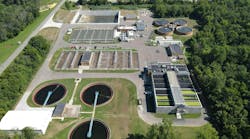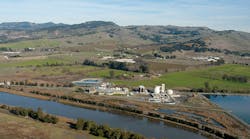Tim Gregorski is editorial director for Water & Wastes Digest. He can be reached at 847/391-1011 or by e-mail at [email protected].
- Name: Chaparral Water Treatment Plant
- Location: Scottsdale, Ariz.
- Plant size: Scottsdale’s new 30 million gallon per day (mgd) water treatment plant treats the city’s Salt River Project Allocation and is projected to meet the drinking water demands south of the Arizona Canal.
- Infrastructure: Scottsdale, Ariz.’s Chaparral Water Treatment Plant incorporates membrane filtration technology following the proven performance of membranes at the nearby Scottsdale Water Campus. A membrane-related treatment process, involving microfiltration and ultrafiltration membranes followed by ozonation and/or granular adsorption, was selected. Associated plant facilities include onsite sodium hypochlorite generation and disinfection facilities, solids dewatering facilities, and a buried 5.5 million gallon water reservoir and water pump station.
It is not often that aesthetics play a crucial role in the design of a 30-mgd water treatment plant. However, aesthetics was one characteristic Black & Veatch engineers kept at the forefront of their design for the Chaparral Plant, as the facility was to be integrated into a 29-acre site amid an upscale neighborhood.
“To blend in with the Scottsdale community, the building and its associated outdoor areas were designed with input from city officials and neighbors,” said Dan Meyer, a Black & Veatch (B&V) project director for the Chaparral Water Treatment. “Many locals, and even more passersby, don’t even realize it is a water treatment plant. The new water facility, landscaping, dog park and recreational amenities have enhanced this highly visible area of the city.”
With location being a critical element, it was essential that the architecture and landscaping of the plant mesh with the surrounding neighborhood. As such, the plant was designed to serve as a backdrop to adjacent Chaparral Park. Architectural sculptures accentuate property around the perimeter of the treatment facility, tensile structures provide 16,000 sq ft of shading, and gabion walls spread from the base of the plant’s walls and into the surrounding park.
“Once the public viewed the plans and artist renderings of the project, the discussion themes changed to ‘How many parking spaces will there be for the park?’ and ‘What type of facilities are included in the dog park?’” said Meyer.
Treatment process
Drawing water from the Salt River Project (SRP), Scottsdale public officials determined the water would need thorough taste and odor control testing, as other plants that draw water from the SRP have experienced such problems. The taste and odor problems can be attributed to methylisoborneol and geosmin, compounds that form with excessive growth of blue-green algae.
B&V was faced not only with the taste and odor problems, but also particulate and arsenic removal and control of disinfection by product when designing the Chaparral Water Treatment Plant.
When developing the design treatment for the plant, B&V opted for a membrane filtration system due to its small footprint and ability to meet the Stage 2 Disinfectants/Disinfection Byproducts Rule. Other variables in the decision to opt for a membrane-related treatment system included cost, the ability to produce high-quality water and the proven success of membrane systems at the nearby Scottsdale Water Campus.
Ultimately, the best membrane-related treatment option for the Chaparral Water Treatment Plant involved a microfiltration/ultrafiltration (UF) membrane system followed by ozonation and/or granular carbon adsorption.
“Membranes were chosen for two reasons,” said Meyer. “First, the city is familiar with their use and application, and is accustomed to their excellent performance. Membranes will treat almost any quality of raw water with the same resulting high quality finished water. The other issue was site constraints and land availability. The process train, treatment equipment and membranes need a much smaller space to operate than conventional treatment.”
The membrane system selected consists of 10 independent ZeeWeed UF membrane process trains manufactured by Zenon Membrane Solutions, part of GE Water & Process Technologies. Each train contains six cassettes containing the UF membrane modules that are partially filled with 52 modules. The plant can be upgraded to meet increased demand by adding more modules to a cassette.
“Although the plant is designed to treat 30 mgd, it has an expansion capability to 36 mgd,” said Meyer. “The service area of the plant has been built out and demand is not predicted to rise substantially. However, should the city desire the 6 mgd additional capacity, expansion space has been built into the facility and only requires the installation of additional membranes.”
As for the treatment process itself, raw water is sent though a 500-micron pre-screen and mixed with ferric coagulant for arsenic removal. Flocculation occurs in a single stage and is followed by the UF process for microbial and particulate removal. Ozonation or granular carbon adsorption is employed to remove taste, odor and disinfection byproduct precursors. Interestingly, the granular carbon adsorption process is bypassed during the winter months when taste and odor in the raw water are below detection limits.
Filtration is achieved by drawing water to the inside of the membrane fiber under a low-pressure suction of -1 to -10 psi. With a nominal pore size of 0.04 microns, the UF membranes form a positive barrier to solids, bacteria, pathogens and certain viruses, retaining them in the process tank.

